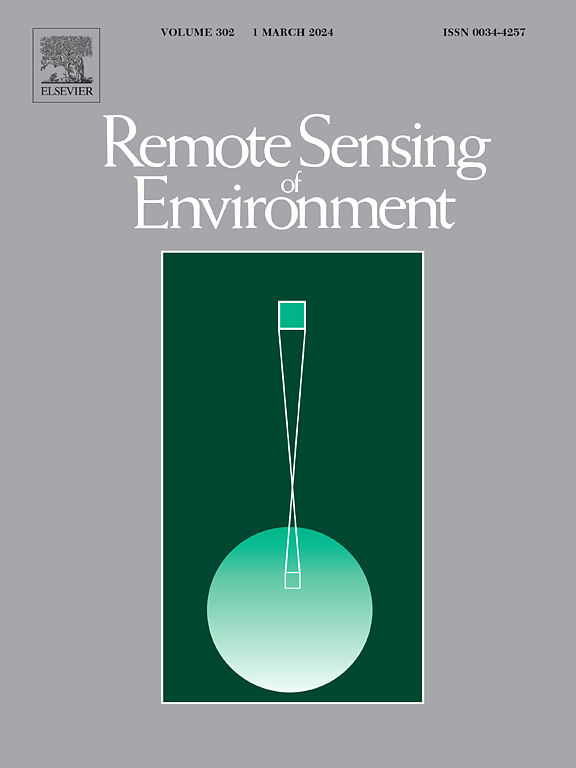Top-of-atmosphere radiometric reference model for stable land sites with relaxed temporal stability requirements and its application to GF6/WFI radiometric calibration and validation
IF 11.1
1区 地球科学
Q1 ENVIRONMENTAL SCIENCES
引用次数: 0
Abstract
A top-of-atmosphere (TOA) reflectance model based on the temporal characteristics of stable land surface targets, such as pseudo-invariant calibration sites (PICSs), was developed to monitor the stability of satellite visible imagers without requiring ground measurements. This model accounts for variations in the viewing zenith angle, solar zenith angle, and atmospheric parameters. To better represent multiple scattering contributions between the surface and atmosphere, we introduced the scattering angle and applied a sinusoidal function with a 365-day period to model seasonal atmospheric variations. Notably, the model does not rely on long-term temporal stability of PICSs, as it primarily characterizes angular and atmospheric variations rather than site-inherent stability. A comprehensive uncertainty analysis, based on a metrology-driven approach, indicates that the model achieves an average uncertainty of better than 4 %. Furthermore, the modeled TOA reflectance maintains long-term radiometric consistency with observations from the Sentinel-2 A/B MSI and Landsat-8/OLI sensors. Across 177 matching observations, the relative difference between observed and modeled values is mostly within 3 %, demonstrating the model's effectiveness. The proposed model is further applied to calibrate the GF6/WFI sensor, with cross-validation conducted using Sentinel-2/MSI and Terra/MODIS observed TOA reflectance as references, while constraining imaging time and viewing geometry. The TOA reflectance calibrated using the proposed model shows improved consistency with the reference TOA reflectance compared to that obtained using official calibration coefficients.
放宽时间稳定性要求的稳定陆点的大气顶辐射参考模型及其在GF6/WFI辐射定标和验证中的应用
为了监测卫星可见光成像仪的稳定性,在不需要地面测量的情况下,建立了一种基于稳定地表目标(如伪不变校准点(pics))时间特征的大气顶(TOA)反射率模型。该模型考虑了观测天顶角、太阳天顶角和大气参数的变化。为了更好地反映地表和大气之间的多重散射贡献,我们引入了散射角,并采用365天周期的正弦函数来模拟季节大气变化。值得注意的是,该模式不依赖于pics的长期时间稳定性,因为它主要表征角度和大气变化,而不是站点固有稳定性。基于计量驱动方法的综合不确定度分析表明,该模型的平均不确定度优于4%。此外,模拟的TOA反射率与Sentinel-2 A/B MSI和Landsat-8/OLI传感器的观测结果保持长期辐射一致性。在177个匹配观测值中,观测值与模型值的相对差异大多在3%以内,表明了模型的有效性。该模型进一步应用于GF6/WFI传感器的校准,并以Sentinel-2/MSI和Terra/MODIS观测到的TOA反射率为参考,在限制成像时间和观测几何形状的情况下进行交叉验证。与使用官方校准系数获得的TOA反射率相比,使用该模型校准的TOA反射率与参考TOA反射率的一致性有所提高。
本文章由计算机程序翻译,如有差异,请以英文原文为准。
求助全文
约1分钟内获得全文
求助全文
来源期刊

Remote Sensing of Environment
环境科学-成像科学与照相技术
CiteScore
25.10
自引率
8.90%
发文量
455
审稿时长
53 days
期刊介绍:
Remote Sensing of Environment (RSE) serves the Earth observation community by disseminating results on the theory, science, applications, and technology that contribute to advancing the field of remote sensing. With a thoroughly interdisciplinary approach, RSE encompasses terrestrial, oceanic, and atmospheric sensing.
The journal emphasizes biophysical and quantitative approaches to remote sensing at local to global scales, covering a diverse range of applications and techniques.
RSE serves as a vital platform for the exchange of knowledge and advancements in the dynamic field of remote sensing.
 求助内容:
求助内容: 应助结果提醒方式:
应助结果提醒方式:


